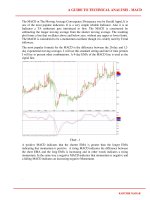Trading systems and money management a guide to trading and profiting in any market
Bạn đang xem bản rút gọn của tài liệu. Xem và tải ngay bản đầy đủ của tài liệu tại đây (3.47 MB, 418 trang )
TRADING SYSTEMS AND
MONEY MANAGEMENT
Other Books in The Irwin Trader’s Edge Series
Techniques of Tape Reading by Vadym Graifer and Christopher Schumacher
Quantitative Trading Strategies by Lars Kestner
Understanding Hedged Scale Trading by Thomas McCafferty
Trading Systems That Work by Thomas Stridsman
The Encyclopedia of Trading Strategies by Jeffrey Owen Katz and
Donna L. McCormick
Technical Analysis for the Trading Professional by Constance Brown
Agricultural Futures and Options by Richard Duncan
The Options Edge by William Gallacher
The Art of the Trade by R. E. McMaster
TRADING SYSTEMS AND
MONEY MANAGEMENT
A Guide to Trading and
Profiting in any Market
THOMAS STRIDSMAN
McGraw-Hill
New York Chicago San Francisco
Lisbon London Madrid Mexico City
Milan New Delhi San Juan Seoul
Singapore Sydney Toronto
Copyright © 2003 by The McGraw-Hill Companies, Inc. All rights reserved. Manufactured in the United States of America.
Except as permitted under the United States Copyright Act of 1976, no part of this publication may be reproduced or distributed in any form or by any means, or stored in a database or retrieval system, without the prior written permission of the
publisher.
0-07-143565-4
The material in this eBook also appears in the print version of this title: 0-07-140019-2
All trademarks are trademarks of their respective owners. Rather than put a trademark symbol after every occurrence of a
trademarked name, we use names in an editorial fashion only, and to the benefit of the trademark owner, with no intention
of infringement of the trademark. Where such designations appear in this book, they have been printed with initial caps.
McGraw-Hill eBooks are available at special quantity discounts to use as premiums and sales promotions, or for use in corporate training programs. For more information, please contact George Hoare, Special Sales, at or (212) 904-4069.
TERMS OF USE
This is a copyrighted work and The McGraw-Hill Companies, Inc. (“McGraw-Hill”) and its licensors reserve all rights in
and to the work. Use of this work is subject to these terms. Except as permitted under the Copyright Act of 1976 and the
right to store and retrieve one copy of the work, you may not decompile, disassemble, reverse engineer, reproduce, modify,
create derivative works based upon, transmit, distribute, disseminate, sell, publish or sublicense the work or any part of it
without McGraw-Hill’s prior consent. You may use the work for your own noncommercial and personal use; any other use
of the work is strictly prohibited. Your right to use the work may be terminated if you fail to comply with these terms.
THE WORK IS PROVIDED “AS IS”. McGRAW-HILL AND ITS LICENSORS MAKE NO GUARANTEES OR WARRANTIES AS TO THE ACCURACY, ADEQUACY OR COMPLETENESS OF OR RESULTS TO BE OBTAINED FROM
USING THE WORK, INCLUDING ANY INFORMATION THAT CAN BE ACCESSED THROUGH THE WORK VIA
HYPERLINK OR OTHERWISE, AND EXPRESSLY DISCLAIM ANY WARRANTY, EXPRESS OR IMPLIED,
INCLUDING BUT NOT LIMITED TO IMPLIED WARRANTIES OF MERCHANTABILITY OR FITNESS FOR A PARTICULAR PURPOSE. McGraw-Hill and its licensors do not warrant or guarantee that the functions contained in the work
will meet your requirements or that its operation will be uninterrupted or error free. Neither McGraw-Hill nor its licensors
shall be liable to you or anyone else for any inaccuracy, error or omission, regardless of cause, in the work or for any damages resulting therefrom. McGraw-Hill has no responsibility for the content of any information accessed through the work.
Under no circumstances shall McGraw-Hill and/or its licensors be liable for any indirect, incidental, special, punitive, consequential or similar damages that result from the use of or inability to use the work, even if any of them has been advised
of the possibility of such damages. This limitation of liability shall apply to any claim or cause whatsoever whether such
claim or cause arises in contract, tort or otherwise.
DOI: 10.1036/0071435654
Want to learn more?
,
We hope you enjoy this McGraw-Hill eBook! If you d like
more information about this book, its author, or related books
and websites, please click here.
This book is dedicated to my entire family in general,
but to the little ones in particular. My niece Matilda and
my nephews Erik and Albin, you make me laugh. One
can only hope that you and your friends get to have a
glass of beer…
Also, with the most sincere hopes for a full and speedy
recovery for my mother after her severe traffic accident.
This page intentionally left blank.
DISCLAIMER
The entire contents of this book, including the trading systems and all the analysis techniques to derive and evaluate them, is intended for educational purposes
only, to provide a perspective on different market and trading concepts. The book
is not meant to recommend or promote any trading system or approach. You are
advised to do your own research to determine the validity of a trading idea and the
way it is presented and evaluated. Past performance does not guarantee future
results; historical testing may not reflect a system’s behavior in real-time trading.
This page intentionally left blank.
For more information about this title, click here.
CONTENTS
INTRODUCTION xvii
ACKNOWLEDGMENTS xxi
PART ONE
HOW TO EVALUATE A SYSTEM 1
Performance Measures 4
Chapter 1
Percentages and Normalized Moves 7
About the Costs of Trading 12
Chapter 2
Calculating Profit 15
Average Profit per Trade 16
Average Winners and Losers 20
Standard Deviation 22
Distribution of Trades 25
Standard Errors and Tests 28
Other Statistical Measures 30
Time in Market 31
ix
Copyright 2003 by The McGraw-Hill Companies, Inc. Click Here for Terms of Use.
Contents
x
Chapter 3
Probability and Percent of Profitable Trades 35
Calculating Profitable Trades 35
The Difference Between Trades and Signals 43
Chapter 4
Risk 47
Calculating Risk 48
A Sample Strategy Analysis 51
Chapter 5
Drawdown and Losses 57
Drawdown Compared to Equity 58
Drawdown Compared to the Market 59
Mean–Median Comparisons 60
Types of Drawdown 63
Chapter 6
Quality Data 67
A Scary Futures-Market Example 71
Understanding Profitability 76
PART TWO
TRADING SYSTEM DEVELOPMENT 79
Chapter 7
TradeStation Coding 83
Export Code 86
Comments on the Code 89
The Exported Data 91
Initial Description of the Systems 95
Chapter 8
Hybrid System No. 1 97
Suggested Markets 97
Contents
xi
Original Rules 97
Test Period 98
Test Data 98
Starting Equity 98
System Pros and Cons 98
Revising the Research and Modifying the System 99
TradeStation Code 102
Chapter 9
RS System No. 1 105
Suggested Markets 105
Original Rules 105
Test Period 106
Test Data 106
Starting Equity 106
System Pros and Cons 106
Revising the Research and Modifying the System 107
TradeStation Code 110
Chapter 10
Meander System V.1.0 113
Suggested Markets 113
Original Rules 114
Test Period 114
Test Data 114
Starting Equity 114
System Pros and Cons 114
Revising the Research and Modifying the System 115
TradeStation Code 120
Chapter 11
Relative Strength Bands 123
Suggested Markets 124
Original Rules 124
Test Period 124
Test Data 124
Starting Equity 124
System Pros and Cons 125
Contents
xii
Revising the Research and Modifying the System 125
TradeStation Code 133
Chapter 12
Rotation 137
Suggested Markets 137
Original Rules 138
Test Period 138
Test Data 138
Starting Equity 138
System Analysis 138
Revising the Research and Modifying the System 139
TradeStation Code 146
Chapter 13
Volume-weighted Average 153
Suggested Markets 154
Original Rules 154
Test Period 154
Test Data 154
Starting Equity 154
System Pros and Cons 154
Revising the Research and Modifying the System 155
TradeStation Code 159
Chapter 14
Harris 3L-R Pattern Variation 163
Suggested Markets 164
Original Rules (Long Trades Only) 164
Test Period 164
Test Data 164
Starting Equity 164
System Pros and Cons 164
Revising the Research and Modifying the System 165
TradeStation Code 171
Contents
xiii
Chapter 15
Expert Exits 173
Suggested Markets 174
Original Rules (Reverse the Logic for Short Trades) 174
Test Period 174
Test Data 174
Starting Equity 174
System Pros and Cons 174
Revising the Research and Modifying the System 175
TradeStation Code 182
Chapter 16
Evaluating System Performance 185
PART THREE
STOPS, FILTERS, AND EXITS
191
Chapter 17
Distribution of Trades 193
Chapter 18
Exits 201
Limiting a Loss 201
Taking a Profit 203
End of Event 204
Money Better Used Elsewhere 205
Chapter 19
Placing Stops 207
Percent Stops 209
Volatility 210
Surface Charts 212
Contents
xiv
Chapter 20
Adding Exits 219
Surface Chart Code 220
Comments on the Code 224
Hybrid System No. 1 226
Stop-loss Version 226
Trailing-stop Version 233
Meander System, V.1.0 237
Stop-loss Version 237
Trailing-stop Version 240
Volume-weighted Average 241
Stop-loss Version 241
Trailing-stop Version 242
Harris 3L-R Pattern Variation 245
Stop-loss Version 246
Trailing-stop Version 247
Expert Exits 248
Stop-loss Version 249
Trailing-stop Version 249
Uncommented Bonus Stops 250
Chapter 21
Systems as Filters 255
RS System No. 1 as the Filter 260
Relative-strength Bands as the Filter 262
Rotation as the Filter 266
Chapter 22
Variables 271
Chapter 23
Evaluating Stops and Exits 281
Contents
xv
PART FOUR
MONEY MANAGEMENT 287
Chapter 24
The Kelly Formula 289
Chapter 25
Fixed Fractional Trading 295
Chapter 26
Dynamic Ratio Money Management 305
Building a Sample Spreadsheet 310
Chapter 27
Spreadsheet Development 325
Money Management Export Code 337
Comments on the Code 341
Chapter 28
Combined Money Market Strategies 343
Strategy 1
Strategy 2
Strategy 3
Strategy 4
Strategy 5
Strategy 6
Strategy 7
Strategy 8
Strategy 9
Strategy 10
Strategy 11
Strategy 12
345
349
352
354
356
358
359
362
363
365
366
369
Contents
xvi
The Counterpunch Stock System 374
Suggested Markets 376
Rules 376
Money Management 376
Test Period 376
Test Data 377
Starting Equity 377
System Analysis 377
Chapter 29
Consistent Strategies 379
Conclusion 382
INDEX 385
INTRODUCTION
“This is Wall Street, no act of kindness will pass unpunished.”
— Unknown
A
s an editor, writer, and technical analysis expert first for Futures magazine and
later Active Trader magazine, I realized that although there are plenty of technical
analysis books in general and on rule-based trading in particular, they were all saying the same thing and not bringing any new thinking into the subject. This is especially true when it comes to the intricate topic of how to build and evaluate a trading
system so that it remains as robust and reliable when traded together with a professional money management regimen in the real world, as it seemed to be when tested on historical data.
In an effort to do something about this, I first wrote Trading Systems That
Work (McGraw-Hill, 2000), which focused on longer-term systems on the futures
markets, and now Trading Systems and Money Management, which focuses on
short-term systems in the stock market. Both books combine featured systems with
a fixed fractional money management regimen to maximize each system’s profit
potential, given the trader’s tolerance for risk.
To combine a mechanical trading system (the rules for where and when to buy
and sell a stock or commodity) with any money management strategy (the rules for
how many to buy and sell, given the trader’s risk–reward preferences and the behavior of the markets), is not as easy as taking any system, applying it to any market
or group of markets, and deciding on not risking a larger amount per trade than
what your wallet can tolerate.
Instead it’s a complex web of intertwining relationships, where any change
between two variables will alter the relationship between all the other variables.
And, as if that’s not enough, the strategy should be dynamic enough to mechanically self-adjust to the ever-changing market environment in such a way that the
xvii
Copyright 2003 by The McGraw-Hill Companies, Inc. Click Here for Terms of Use.
xviii
Introduction
risk–reward potential remains approximately the same for all markets and time
periods.
This book is for those traders who haven’t been able to pinpoint what is missing to make the complete strategy larger than the sum of its parts. If you allow me
to take a guess, I’d guess that what you feel is keeping you from succeeding as a
trader is the overall understanding for how it all ties together and what really constitutes a more “sophisticated” strategy with a higher likelihood for success than
the ones you’re currently using. The way I see it, to simplify things, the development process could be divided into a few building blocks:
First, we need to learn what we need to measure to achieve robustness and
reliability. Second, we need to learn to formulate and test the logic for the entry
(and possibly also some sort of filtering technique). Third, we must understand and
test different types of exits. The last point of actual research is to apply and test the
money management according to our risk preferences.
The first part of the book will show you how to measure a system’s performance to make it as forward-looking as possible. By forward-looking we mean
that the likelihood for the future results resembling the historical results should be
as high as possible. To do this, you will need to know the difference between a
good working system and a profitable system and which evaluation parameters to
use to distinguish between the two.
The emphasis will lie on making the system work, on average, equally as
well on a large number of markets and time periods. We also will look at other
common system-testing pitfalls, such as working with bad data and not normalizing the results. Another important consideration is to understand what constitutes
realistic results and what types of results to strive for. A lot of the analysis work
will be done in TradeStation and MS Excel.
In the second part, we will take a closer look at the systems we will work
with throughout the rest of the book. All eight systems have previously been featured in Active Trader magazine’s Systems Trading lab pages. The systems are
selected only as good learning experiences, not for their profitability or trading
results. We will look at the systems one at a time and determine how we can modify them to make them more robust and forward-looking.
All changes will be based on logic and reasoning, rather than optimization
and curve fitting, and are aimed to improve the system’s average performance over
a large number of markets and time periods, rather than optimizing the profits for
a few select markets. The working premise will be, the better we understand the
logic behind the system and the less complex the system, the more we trust it will
function as well in the future as it has in the past. For this, we will do most of the
work in MS Excel, which means we need to learn how to export the data from our
analysis software of choice.
Usually when I build a system, I don’t count the stop-loss and exit rules to
the core system logic. In Part 3 we therefore substitute all the old exit rules for all
Introduction
xix
systems with a set of new rules, optimized to work on average equally as well on
all markets at all times. To do this, we need to understand what types of exits are
available, how to evaluate them, and how to avoid falling into any of the problems
that adhere explicitly to the evaluation of exits. However, even though the larger
part of Part 3 deals explicitly with stops and exits, the methods used (such as analyzing the results with a surface chart in MS Excel) also are applicable to other
parts of the system-building process.
At the end of this part, we also will take a look at how to increase performance by adding a relative-strength or trend filter. Decreasing the number of trades
might decrease the performance for any individual market, but by making room
for more trades in more markets, we can increase performance thanks to a higher
degree of diversification.
The last part of the book will tie it all together by applying a dynamic ratio
money management (DRMM) regimen on top of all the trading rules. With
DRMM, all markets traded will share the same account, so that the result for one
market is dependent on the results from all other markets and how much we decide
to risk in each trade. Also, the number of possible markets to be traded simultaneously and the amount risked per share in relation to the total amount risked of
account equity will vary with the conditions of the markets.
Using DRMM, we also can tailor the amount risked per trade to fit our exact
tolerance for risk given the system’s statistical characteristics and expected market
conditions. In this case, instead of optimizing the equity growth, we will optimize
the smoothness of the equity curve. Even with this modest goal, we will achieve
results far higher and better than comparable buy-and-hold strategies. But before
we set out to test the systems using DRMM, in our custom-made Excel spreadsheet, we will learn exactly how DRMM works with all its mathematical formulas
and why it is the supreme money management method.
However, when moving back and forth between the different steps in the
development process we have to understand that any little change under any of
these categories also will alter the characteristics produced by the others. Therefore,
building a trading system is a never-ending task of complex intertwining dynamics
that constantly alter the work process. This really creates a fifth element that runs
through the entire process as a foundation for the other elements to rest on.
The fifth element is the philosophic understanding of how all the other parts
fit together in the never-ending work process already mentioned. If anything, I
hope that what makes this book unique is the overall understanding for the entire
process and the way it will force you to think outside of the conventional box.
Developing a trading strategy is like creating a “process machine,” in which
each decision automatically and immediately leads to the next one, and next one,
and next one … producing a long string of interacting decisions forming a process
with no beginning or end. I further believe it is paramount to look at both the
development and the execution of the strategy in the same way.
xx
Introduction
The purpose of this book is not to give you the best ready-made systems, but
to show you how to go about developing your own systems—a development process
that eventually and hopefully will allow you to put together a trading strategy that is
a long-term work process as opposed to a series of single, isolated decisions.
The advantage of the concept of a work process, in comparison with decision,
is that rule-based trading can be understood as a form of problem solving, using the
four P’s of speculation: philosophy, principles, procedures, and performance.
The emphasis in this book seems to be on the principles, procedures, and performance, but while reading we also need to at least try to understand the philosophy behind it all, because it is the philosophy that ties it all together and explains
the value of the suggested principles and procedures in the rest of the book. That
is what this book really is about. Good luck with your studying and trading.
ACKNOWLEDGMENTS
My most heartfelt gratitude to Dan and Maryanne Gramza.
Many thanks to Nelson Freeburg and his family.
My most sincere wishes for the future success of Active Trader magazine and
its crew, Phil, Bob, Mark, Laura, Amy, and that other weird guy—you’re the best.
There are no better friends than my dear friends Jill in Rockford, IL and Pär
in Västerås, Sweden. Thanks for putting up with me.
To Robert, Brad, and the rest of the bunch at Rotella Capital: It’s a true honor
to work with and for you all. A special thanks to Rafael Molinero, for invaluable
help with this book.
Copyright 2003 by The McGraw-Hill Companies, Inc. Click Here for Terms of Use.
This page intentionally left blank.
PART
ONE
How to Evaluate a System
A
t the time of this writing, there’s a TV commercial running on several of the
business and news channels. The commercial is for an online direct-access brokerage company that claims to give you better fills than the brokerage company
your cubicle-sharing colleague is using. The plot is as follows: Guy 1 proudly tells
Guy 2 that he just bought 300 shares of XYZ for $25.10, only to hear that Guy 2
just bought 200 shares of the very same stock for $25.05. Of course, this 5-cent
difference makes Guy 1 all upset, and Guy 2 takes advantage of it by smugly alerting everyone to “Tom’s unfortunate stock purchase” over the company intercom
system.
Obviously, the purpose of the commercial is to make us believe that the most
important thing in trading isn’t a long-term plan, involving such “mundane” factors as the underlying logic of your system and numbers of shares to trade, but only
to get a 5-cent better fill than your cubicle buddy.
This is a good example of how many companies within the investment and
trading industry don’t know what they’re talking about. Or if they do, they want to
fool you into focusing on the wrong things, because if you were focusing on the
right things, their services would be obsolete. I really don’t know which is worse.
Basically, two types of companies try to feed on your trading. The brokerage
companies try to make you believe that a 5-cent better fill makes all the difference
in the world. The newsletter and market-guru companies claim that only their topand-bottom-picking system will help you squeeze those extra 10 cents out of each
trade, which will take your account equity to astronomical heights (or at least,
finally make you profitable).
The truth is those few extra cents matter little in the end. To understand this,
let’s return to the guys in the cubicle and assume that XYZ indeed started to move
Copyright 2003 by The McGraw-Hill Companies, Inc. Click Here for Terms of Use.









